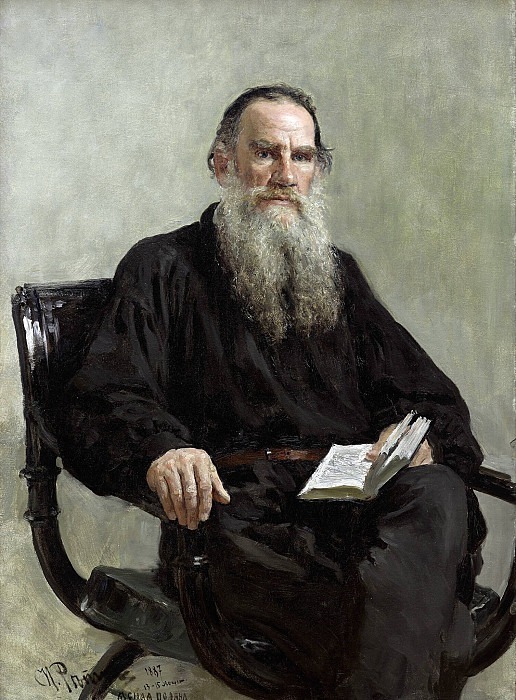Portrait of the writer Lev Tolstoy Ilya Repin (1844-1930)
Ilya Repin – Portrait of the writer Lev Tolstoy
Edit attribution
Download full size: 1508×2048 px (0,5 Mb)
Painter: Ilya Repin
Location: The State Tretyakov Gallery, Moscow (Государственная Третьяковская галерея).
Tolstoy and Repin enjoyed a tender, warm friendship for many years, despite the fact that they disagreed on many issues and often argued heatedly, causing those around them to feel that they were quarreling. In fact, by clashing points of view, the friends found common ground, got to know each other better, or simply practiced witticism, thus entertaining each other. "Portrait of Tolstoy" is one of his many portraits painted by Repin.
Description of Ilya Repin’s painting "Portrait of Tolstoy".
Tolstoy and Repin enjoyed a tender, warm friendship for many years, despite the fact that they disagreed on many issues and often argued heatedly, causing those around them to feel that they were quarreling. In fact, by clashing points of view, the friends found common ground, got to know each other better, or simply practiced witticism, thus entertaining each other.
"Portrait of Tolstoy" is one of his many portraits painted by Repin. It is natural for any artist to paint people close to him, and Repin was no exception. He depicted Tolstoy in an armchair, in a moment of reading, relaxed brooding. Most likely, seeing the interesting pose, which, in his opinion, expressed the writer’s inner essence, Repin asked him to take it again, in order to sketch it and preserve it for eternity.
In the picture Tolstoy sits in an armchair, one hand resting on the armrest, the other holding a small book. He is wearing a black blouse tied at the waist with a belt - against his will, he associates it with the priest’s robes. A fluffy white beard rests on Tolstoy’s chest. His eyes look slightly away from the viewer - the writer has just lifted them from the book, and in them glows a certain question, over which he interrupted his reading.
Perhaps, at that moment, when his pose was moving and alive, and no one was still thinking about the painting, he turned to Repin with a question, but in the portrait his pensiveness is not resolved, enclosed inside. The background of the picture is blurred, it does not play a role in the fate of the shown person - it can be a garden, or a living room, or a veranda, which, for lack of need, Repin simply did not show.
To paint Tolstoy so managed only Repin. With undoubted respect, attention to his personality, with the drawing of details - down to the smallest hair in his beard. So you can write only a friend, but not a casual acquaintance and customer. And the question that shines in Tolstoy’s deep-set eyes may have found an answer in Repin.
Кому понравилось
Пожалуйста, подождите
На эту операцию может потребоваться несколько секунд.
Информация появится в новом окне,
если открытие новых окон не запрещено в настройках вашего браузера.
You need to login
Для работы с коллекциями – пожалуйста, войдите в аккаунт (open in new window).




















You cannot comment Why?
Tolstoy is dressed in a simple, dark robe or tunic, which covers his body and gives him an almost ascetic or spiritual appearance. His left hand rests on the armrest of the chair, while his right hand holds open a small book, its pages light against the dark fabric of his robe and trousers. The book appears to be held at an angle, as if he has just paused his reading or is about to resume.
The background is plain and neutral, a muted gray-green that allows Tolstoy to be the sole focus of the painting. The lighting is somewhat dramatic, casting soft shadows and highlighting the texture of his beard, the lines on his face, and the folds of his clothing.
The subtexts of this portrait are rich and multifaceted. The book in his hand immediately signifies his identity as a writer and intellectual. His thoughtful expression and the weariness in his face could allude to the profound philosophical and moral questions he grappled with throughout his life and explored in his works. The dark, simple attire might suggest his later embrace of a more ascetic lifestyle, his renunciation of worldly possessions, and his spiritual seeking. The overall impression is one of wisdom, gravitas, and deep introspection, capturing the essence of a man known for his literary genius and his complex spiritual journey.